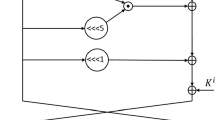Abstract
ASCON is a sponge function based authenticated encryption (AE) scheme chosen in CAESAR competition for lightweight applications. Its suitability for high performance applications make it desirable in environments like Internet of Things (IoT) where large number of very constrained devices communicate with high-end servers. The drawback is that fault analyses like Statistical Ineffective fault attack (SIFA) and Sub-Set Fault Analysis (SSFA) are possible. In this paper, we modify ASCON 128a exploiting the pseudo-random properties of Cellular Automata (CA) to prevent these attacks.
Access this chapter
Tax calculation will be finalised at checkout
Purchases are for personal use only
Similar content being viewed by others
References
Benot, O.: Encyclopedia of Cryptography and Security, pp. 218–219. Springer, Boston (2011)
Bhaumik, J.: Synthesis of all maximum length cellular automata of cell size up to 12. arXiv preprint https://arxiv.org/pdf/1503.04006.pdf (2015). Accessed 04 Sept 2020
Dobraunig, C., Eichlseder, M., Mendel, F., Schläffer, M.: ASCON v1.2. submission to NIST (2019). https://csrc.nist.gov/CSRC/media/Projects/lightweight-cryptography/documents/round-2/spec-doc-rnd2/ascon-spec-round2.pdf. Accessed 04 Sept 2020
Giraud, C., Thiebeauld, H.: A survey on fault attacks. International Federation for Information Processing Digital Library; Smart Card Research and Advanced Applications VI, 153, January 2004
de la Guía Martínez, D., Peinado Domínguez, A., et al.: On the sequences generated by 90-150 programmable cellular automata. In: 5th World Multiconference on Systemics, Cybernetics and Informatics and 7th International Conference on Information System Analysis and Synthesis (SCI/ISAS), Orlando, Florida. International Institute of Informatics and Systemics, July 2001
Joshi, P., Mazumdar, B.: A sub-set fault analysis attack on ASCON (2019). https://eprint.iacr.org/2019/1370. Accessed 04 Sept (2020)
Nandi, S., Kar, B.K., Pal Chaudhuri, P.: Theory and applications of cellular automata in cryptography. IEEE Trans. Comput. 43(12), 1346–1357 (1994)
Ramezanpour, K., Ampadu, P., Diehl, W.: A statistical fault analysis methodology for the ASCON authenticated cipher. In: 2019 IEEE International Symposium on Hardware Oriented Security and Trust (HOST), pp. 41–50. IEEE (2019)
Rogaway, P.: Authenticated-encryption with associated-data. In: Proceedings of the 9th ACM Conference on Computer and Communications Security, pp. 98–107 (2002)
Wolfram, S.: Cellular automata as models of complexity. Nature 311(5985), 419–424 (1984)
Author information
Authors and Affiliations
Corresponding author
Editor information
Editors and Affiliations
Rights and permissions
Copyright information
© 2021 Springer Nature Switzerland AG
About this paper
Cite this paper
Jacob, J., Joseph, J., Abinshad, M.K., Ambili, K.N., Jose, J. (2021). Prevention of Fault Attacks in ASCON Authenticated Cipher Using Cellular Automata. In: Gwizdałła, T.M., Manzoni, L., Sirakoulis, G.C., Bandini, S., Podlaski, K. (eds) Cellular Automata. ACRI 2020. Lecture Notes in Computer Science(), vol 12599. Springer, Cham. https://doi.org/10.1007/978-3-030-69480-7_3
Download citation
DOI: https://doi.org/10.1007/978-3-030-69480-7_3
Published:
Publisher Name: Springer, Cham
Print ISBN: 978-3-030-69479-1
Online ISBN: 978-3-030-69480-7
eBook Packages: Computer ScienceComputer Science (R0)




